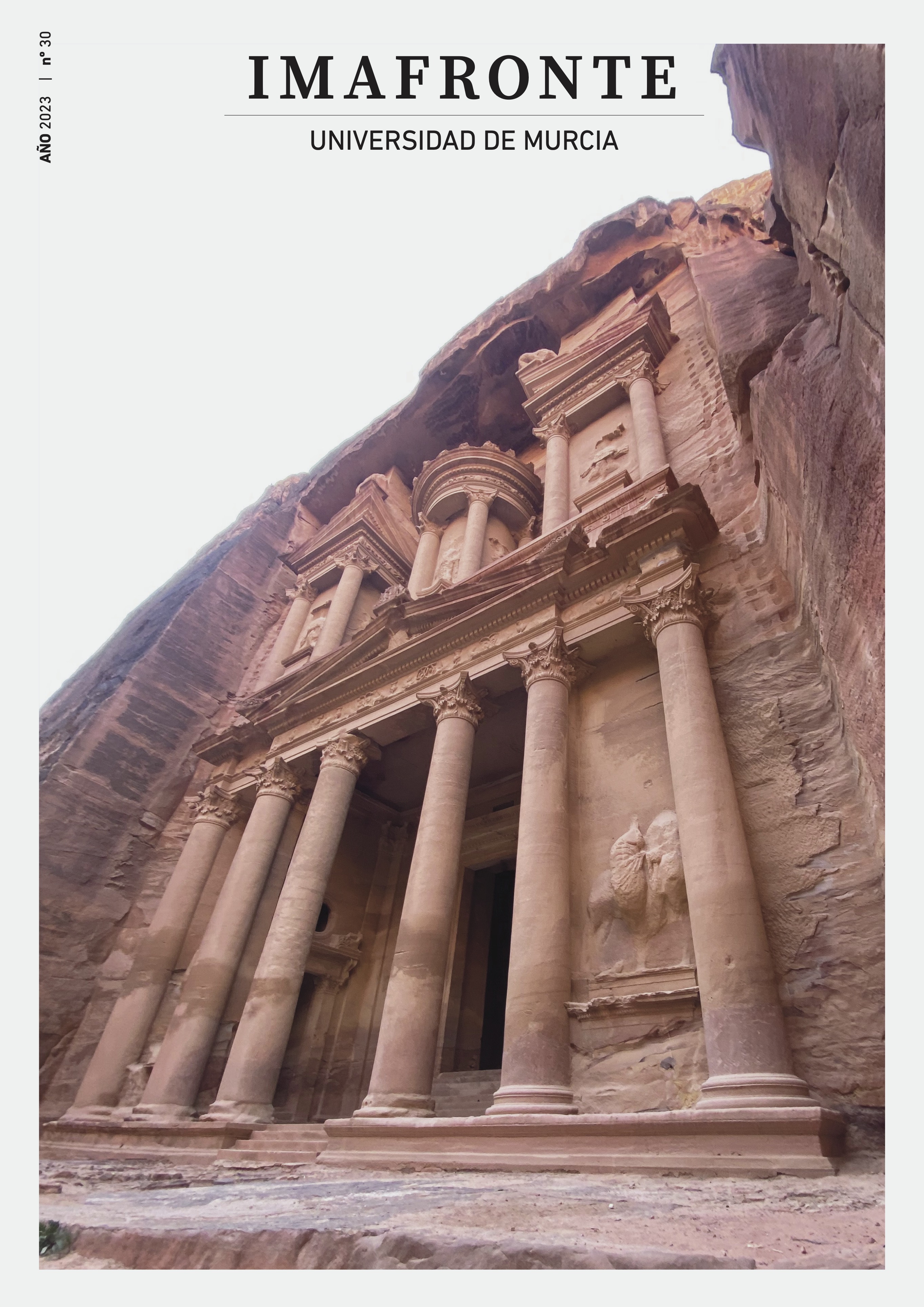De la visualización al (con)tacto devoto. Aproximación a la interpretación física con las hermas griegas
Resumen
En el presente estudio, se subraya la importancia de adoptar como instrumento de análisis la interacción no sólo visual, sino física con la imagen divina griega denominada “herma”. Partiendo de su bifuncionalidad, se pretende esbozar una interpretación del significado del contacto físico directo del devoto griego con esta estatua a partir de la evidencia iconográfica y literaria antigua, vinculado a una funcionalidad primaria ritual de esta imagen y a su omnipresencia en el paisaje urbano y rural ateniense. En último lugar, se sugiere la adopción del término “devoto-tocador” para referir a la comprensión y percepción antigua del lenguaje visual semi-antropomorfo de estas imágenes, y de la identidad divina que cobijan.
Descargas
-
Resumen944
-
PDF507
-
EPUB335
Citas
Allan, A. (2018). Hermes. London-New York: Routledge.
Ballesteros, S. (1993). “Percepción háptica de objetos y patrones realzados: una revisión”. Psicothema, 5, n. 2, 1993, pp. 311-321.
Bettinetti, S. (2001). La statua di culto nella pratica rituale greca. Bari: Levante.
Collard, H. (2019). “Communicating with the Divine: Herms in Attic Vase Painting”. En J.F. Miller & J. Strauss Clay, Tracking Hermes, Pursuing Mercury. Oxford: Oxford University Press, 227-244.
Collignon, M. (1911). Les Statues funéraires dans l'Art grec. Paris: Ernest Leroux.
Crome, J. F. (1935/1936). “Hipparcheioi Ermai”. AM, 60–61, 300-313.
Curtius, L (1903). Die Antike Herme. Eine Mythologisch-Kunstgeschichtliche Studie. Leipzig: Druck von B.G. Teubner.
Delattre, C. (2007). “La statue sur le rivage: récits de pêche miraculeuse”. En Objets sacrés, objets magiques de l’Antiquité au Moyen Age, editado por C. Delattre, 65-82. Picard.
Devambez, P. (1968). “Piliers hermaïques et stéles”. Revue Archéologique, 1, 1968, pp. 139-154.
Doyle, J. (2020). “All of a Heap. Hermes and the Stone Cairn in Greek Antiquity”, in Cultures of Stone. An Interdisciplinary Approach to the Materiality of Stone edited by G. Cooney – B. Gilhooly – N. Kelly – S. Mallía, 261-272. Leiden: Sidestone Press.
Fredal, J. (2002). “Herm Choppers, the Adonia, and Rhetorical Action in Ancient Greece”. College English, 64, n. 5, 590–612.
Frontisi-Ducroux, F. (1986). “Les limites de l'anthropomorphisme: Hermès et Dionysos”. En Corps des dieux edited by C. Malamoud & J.P. Vernant, 193-211. Paris: Gallimard.
Frontisi-Ducroux, F. (1991) Le Dieu-Masque: une figure du Dionysos d'Athènes. Paris-Rome: La Découverte - Ecole Française de Rome.
Furley, W. D. (1986) Andokides and the Herms: A Study of Crisis in fifth-century Athenian Religion (Bulletin of the Institute of Classical Studies. Supplement; 65). London: University of London.
Goldman, H. (1942). “The Origin of the Greek Herm”. AJA, 46, 58-68.
Harrison, E. B. (1965) Archaic and Archaistic Sculpture (The Athenian Agora vol. 11). Princeton: American School of Classical Studies at Athens.
Hedreen, G. (2014). “The Artificial Sculptural Image of Dionysos in Athenian Vase Painting and the Mythological Discourse of Early Greek Life”. En A. Avramidou & D. Demetriou, Approaching the Ancient Artifact: Representation, Narrative, and Function. A Festschrift in honor of H. Alan Shapiro Berlin-Boston, 267-280.
Anonimizado 2023
Jaillard, D. (2001) “Le pilier hermaïque dans l'espace sacrificiel”. Mélanges de l'École Française de Rome. Antiquité, 113, 341-363.
Lacroix, L. (1949). Les Reproductions De Statues Sur Les Monnaies Grecques: La Statuaire Archaique Et Classique. Liége; Paris: Faculté de Philosophie et Lettres.
Lissarrague, F. (2022). “Writing on Architectural Structure”. En Image, Text, Stone: Intermedial Perspectives on Graeco-Roman Sculpture, edited by Dietrich, Nikolaus and Fouquet, Johannes. Berlin, Boston: De Gruyter.
Lullies, R. (1931). Die Typen der griechischen Herme, Königsberg: Gräfe and Unze.
May, J. M. (1950). Ainos: Its History and Coinage. Oxford; London: Oxford University Press; G. Cumberlege.
McNiven, T. J. (2009). "Things to Which We Give Service: Interactions with Sacred Images on Athenian Pottery". En An Archaeology of Representations: Ancient Greek Vase-Painting and Contemporary Methodologies, edited by Dimitrios Yatromanolakis. Athens: Institut du Livre A. Kardamitsa, 298-325.
Mylonopoulos, J. (2010). “Divine Images versus Cult Images: An Endless Story about Theories, Methods, and Terminologies”. En Divine Images and Human Imaginations in Greece and Rome, edited by J. Mylonopoulos, Leiden-Boston, 1-20.
Nilsson, M. P. (1940). Greek Popular Religion. New York: Columbia University Press.
Osborne, R. (1985). “The erection and mutilation of the Hermai”. Proceedings of the Cambridge Philological Society.
Petrovic, I. (2010) "The life story of a cult statue as an allegory: Kallimachos’ Hermes Perpheraios", in Divine Images and Human Imaginations in Ancient Greece and Rome, edited by Joannis Mylonopoulos. Leiden: Brill, 205-224.
Rückert, B. (1998). Die Herme im ö ffentlichen und privaten Leben der Griechen: Untersuchungen zur Funktion der griechischen Herme als Grenzmal, Inschriftenträ ger und Kulturbild des Hermes. Regensburg.
Shapiro, H. A. (1989). Art and Cult Under the Tyrants in Athens. Mayence, Ph. von Zabern.
Steiner, D. (2001) T. Images in Mind: Statues in Archaic and Classical Greek Literature and Thought. Princeton: Princeton University Press.
Tanner, J. (2009). The invention of art history in ancient Greece: religion, society, and artistic rationalisation. Cambridge: University Press.
Tekin, O. (2021). “Parasema of the two cities on their coins and weights: The Lion of Lysimacheia and the Hermes Throne of Ainos”. En Thrace – Local coinage and regional identity, edited by Ulrike Peter, Vladimir F. Stolba. Berlin: Topoi Edition, 115-123.
Tomás García, J. (2017) “Definición y contextos de las imágenes de culto en la Grecia antigua”. Euphrosyne, 45, 25-40.
Versnel, H. S. (2011). Coping with the gods. Wayward readings in Greek Theology. Leiden-Boston: Brill.
Weddle, P. (2010). Touching the Gods: physical interaction with cult statues in the Roman world. Durham University: Doctoral thesis.
Willers, D. (1967). “Zum Hermes Propylaios des Alkamenes”, JDAI, 82, 37-109.
Zanker, P. (1965). Wandel der Hermesgestalt in der Attischen Vasenmalerei. Bonn.
Derechos de autor 2023 Pelayo Huerta Segovia

Esta obra está bajo una licencia internacional Creative Commons Atribución-CompartirIgual 4.0.
Las obras que se publican en esta revista están sujetas a los siguientes términos:
1. Los autores ceden de forma no exclusiva a la revista los derechos de explotación (reproducción, distribución, comunicación y transformación).
2. Las obras que se publican en esta revista están sujetas a la licencia Attribution-ShareAlike 4.0 International (CC By SA 4.0). Por lo que se pueden copiar, usar, difundir, transmitir y exponer públicamente, siempre que:
i) se cite la autoría y la fuente original de su publicación (revista, editorial y URL de la obra), permitiendo así su reconocimiento.
ii) se permite remezclar, transfromar o crear a partir del material mientras se mantenga la misma licencia del original.
3. Condiciones de auto-archivo. Se permite y se anima a los autores a difundir electrónicamente las versiones pre-print (versión antes de ser evaluada) y/o post-print (versión evaluada y aceptada para su publicación) de sus obras antes de su publicación, ya que favorece su circulación y difusión más temprana y con ello un posible aumento en su citación y alcance entre la comunidad académica. Color RoMEO: verde.
























